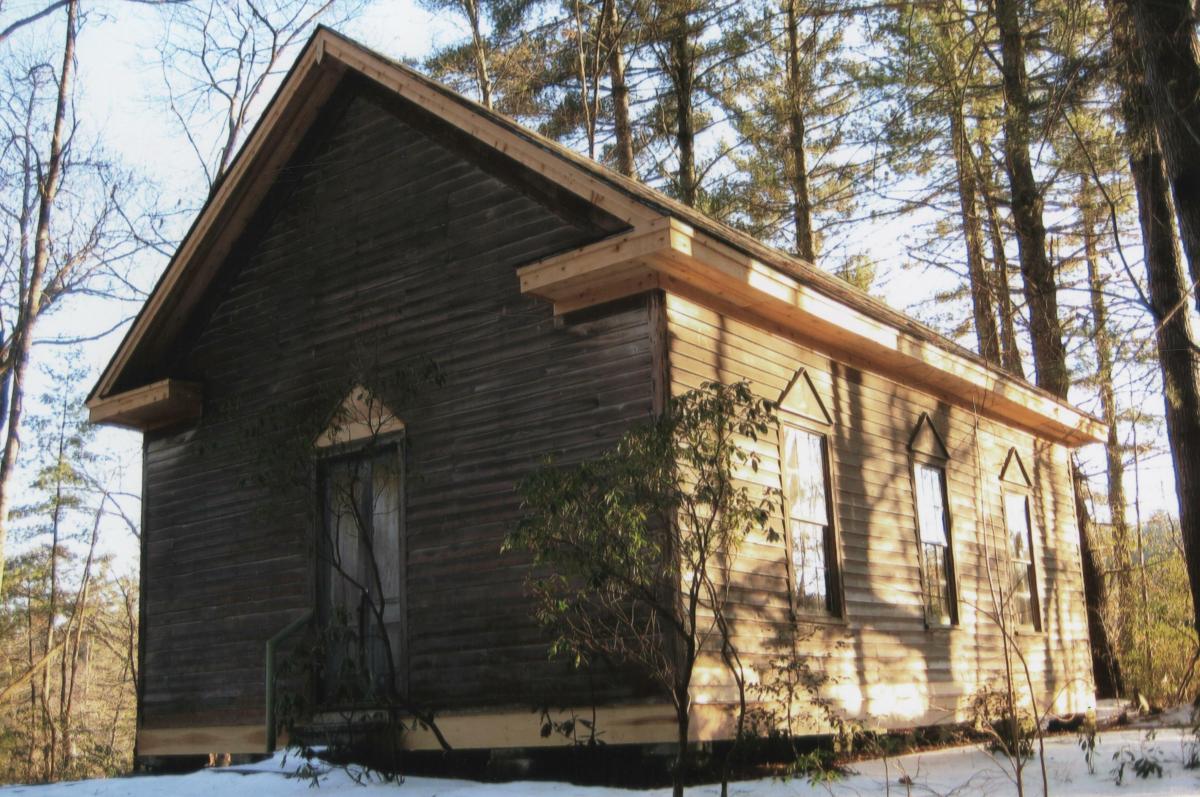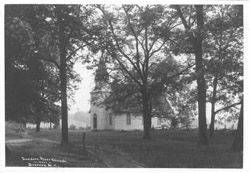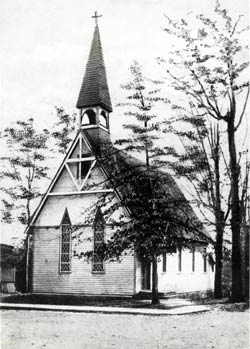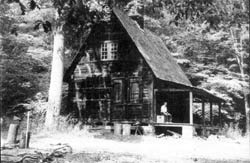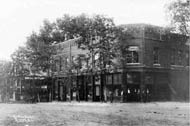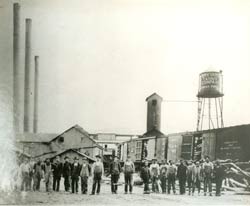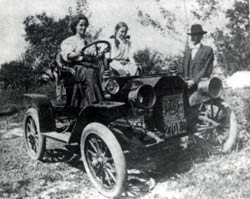In Transylvania County | 1861-1911
1861
-
February 15: NC General Assembly passes act to establish Transylvania County from Jackson and Henderson Counties. Joseph P. Jordan introduced the act and named the county “Transylvania”. John Willis Ellis was governor (1859-1861)
-
Civil War, April 12 - April 9, 1865. Many men in Transylvania County volunteered to serve in the Confederacy but others joined the Union Army. No Civil War battles were fought in this county but it did become a haven for outliers and
 bushwackers – deserters and those avoiding induction. Frequently, they took advantage of sectional tensions and wreaked havoc on the countryside.
bushwackers – deserters and those avoiding induction. Frequently, they took advantage of sectional tensions and wreaked havoc on the countryside.
- May 20: Secession of North Carolina from the Union
-
May 20: Court was opened and held at the home of B. C. Lankford. Thus the founding fathers met to create a county government. On the second day of meetings county officials named a board of common schools, which became the founding governance body of what would one day become the Transylvania County Schools.
-
The county seat was to be located in a place most convenient to the majority of the citizens and should be called Brevard in honor of Col. Ephraim Brevard, MD, a Revolutionary War hero and patriot. B. C. Lankford, L. S. Gash and Alex English donated 50 acres of land for the Town of Brevard.
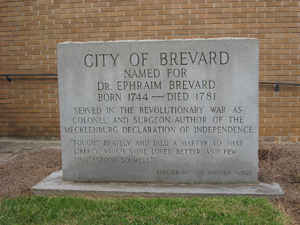 The survey of the townsite was made by James Killian, Chairman of the County Court, W. Probart Poor and Charlie Patton. They were authorized to set aside space for public buildings and three churches and to sell the remaining lots at public auction.
The survey of the townsite was made by James Killian, Chairman of the County Court, W. Probart Poor and Charlie Patton. They were authorized to set aside space for public buildings and three churches and to sell the remaining lots at public auction.
1862
- Board of Tax Listings for May 3 listed a total of 447 slaves and 3 free Negroes
1865
- African Americans in Transylvania County established French Broad and Bethel Baptist Churches
1866
-
The first Transylvania County Courthouse was a wood-frame building constructed in 1866 by George Clayton and Ephriam England for approximately $4,500.00. In 1879 a brick structure was started to house both the courthouse and a jail - this project was completed in 1881. The courthouse was expanded and a larger jail constructed in 1920. These structures were renovated in 1983 to retain their aesthetic and historic significance.
-
Brevard town incorporated (had only seven voters and a population 50+) as the county seat
- Brevard granted a postmaster. First post office in Leander S. Gash’s store on Probart Street, later to be known as the “Red House”
1869
- First Baptist Church in Brevard organized in The Log Cabin (Baptist Church in Cathey’s Creek about 1813. Burned down with records in 1820.)
1870
- There were 365 farms in Transylvania County
1872
- McGaha Chapel - early Methodist Church
1873
- Site deeded on North Gaston Street, Brevard, to B.C. Lankford & Trustees for the Methodist Episcopal Church, South.
1874
- The Board of County Commissioners appropriated $12,000 toward building a brick courthouse and jail
1879
-
First school building constructed at Quebec
- County Commissioners approved plans for the County Courthouse
1881
-
County Courthouse construction was completed. Thomas Davis was the contra
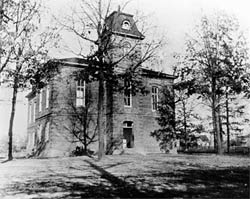 ctor. It was accepted by the county on February 7. Listedon the National Register of Historic Places, the two-story brick building is a modest but impressive example of Italianate Victorian architecture.
ctor. It was accepted by the county on February 7. Listedon the National Register of Historic Places, the two-story brick building is a modest but impressive example of Italianate Victorian architecture.
-
This was the year an ambitious scheme was launched to build a passenger steamboat. Plans were that this steamer, named the Mountain Lily, would carry passengers and freight between the French Broad River and the junction
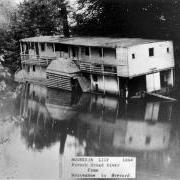 of the Oklawaha River, a distance of 17 miles. The steamboat, launched on August 2, 1881, from Horse Shoe, was operated by the French Broad Steamboat Company and owned by Col. S. V. Pickens of Hendersonville. The boat was 90 feet long and could accommodate 100 passengers on its two decks. A flash flood in 1885 pulled the Mountain Lily from its mooring where it was anchored at Banner Farm Road. It was mired on a sandbar and due to its weight could not be refloated. The wood was salvaged and used to build the Horseshoe Baptist Church. Its bell which rang from the bridge was installed in the belfry and called people to church.
of the Oklawaha River, a distance of 17 miles. The steamboat, launched on August 2, 1881, from Horse Shoe, was operated by the French Broad Steamboat Company and owned by Col. S. V. Pickens of Hendersonville. The boat was 90 feet long and could accommodate 100 passengers on its two decks. A flash flood in 1885 pulled the Mountain Lily from its mooring where it was anchored at Banner Farm Road. It was mired on a sandbar and due to its weight could not be refloated. The wood was salvaged and used to build the Horseshoe Baptist Church. Its bell which rang from the bridge was installed in the belfry and called people to church.
-
Printing of The Transylvania Pioneer began in
Transylvania County
-
Davidson River Church, Sunday School started
-
In an annual report sent to Raleigh, then school
Superintendent Whit Brooks reported “the need of this county is a larger school fund, enabling committees to pay good salaries thereby securing good teachers” (Transylvania County Board of Education, 1887).
1888
-
Newspaper: The French Broad Voice
- George Vanderbilt purchased thousands of acres on which to build the Biltmore Estate
1890
-
Turnpike constructed from Brevard, through (what became) Rosman to Cashiers
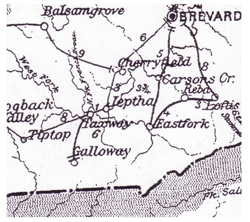
-
First school building constructed in Gloucester
-
Death of Dr. A. J. Lyday who practiced medicine locally since 1846
-
The Western North Carolina Republican served the region
-
By this date, what was refered to as “The Settlement” established a Post Office called Jeptha and operated until August 1901. Mail was then sent to Toxaway (now Rosman)
- There were 877 farms. Outbuildings had become essential to everyday operation
1891
-
French Broad Hustler, a Democratic paper served the region
-
Construction of original white-framed church, known as St.Paul’s in the Valley (forerunner of St. Philips Episcopal Church) - first constructed in 1856.
- Town of Brevard deeded land for Brevard Presbyterian Church
1892
- The Sapphire Valley Mining Company began mining corundum along the Horsepasture River
1894
-
Birth of Loretta Mary Aiken, known as Jackie “Moms Mabley”, billed as “the funniest woman in the world”

1895
-
October 25: First railroad line completed from
 Hendersonville to Brevard (H and B Railroad)
Hendersonville to Brevard (H and B Railroad)
-
J. Frances Hayes formed the Toxaway Company
-
About this time the first plank road constructed under direction of Dr. Carl A. Schenck
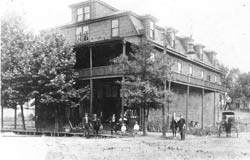
-
Clayton House (Hotel) was built in about 1895 on the corner of Main Street and Caldwell Street. It was owned by Joe and Belle Clayton It was also referred to as “the tin hotel” because its siding was tin. On the first floor there was a lobby, the kitchen and a general store. Family quarters and guest rooms were located on the second and third floors.
-
French Broad Hustler moved to Hendersonville;
 The Sylvan Valley News started
The Sylvan Valley News started
-
Epworth School founded by Fitch and Sarah Taylor. Mrs. Epworth’s school began at the Henning Inn, then moved to the Red House and became Brevard Institute. It later had a large
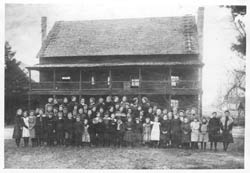 campus on North Broad Street at the current site of Brevard College.
campus on North Broad Street at the current site of Brevard College.
1896
-
J. Frances Hayes built Lake Fairfield and the Fairfield Inn, a modern summer hotel with all the conveniences and comforts including electric lights and indoor toilets. The Fairfield Inn was dismantled in the mid-80s and the land was sold.
- The Toxaway Company was founded and the Toxaway River dammed
1897
-
A colored Baptist Church” listed (Brevard Clipper, September 16)
- J. Frances Hayes built Lake Sapphire and The Sapphire Inn
-
Biltmore Forest School (first in America) started by
Dr. Carl Alwin Schenck
- J. Frances Hayes purchased the Hendersonville and Brevard Railroad at a receiver’s sale on April 29 - later renamed the Transylvania Railroad
-
First brick commercial building (McMinn Building)
erected by Nathan McMinn
1900
-
Toxaway Company built the Franklin Hotel ($25,000)

-
Railroad extended to nine miles south of Brevard to Toxaway (now Rosman). Travelers could travel from Asheville, through Biltmore to Hendersonville on the Southern Railroad. Then switch to the Transylvania Railroad going through Brevard to
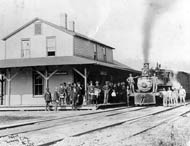 Toxaway.
Toxaway.
-
The Franklin Hotel opened with rooms for 200 visitors
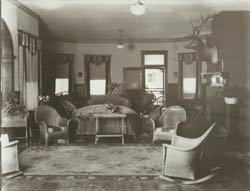
- First school established in Gloucester
1901
- In 1901 the people living in and around the settlement called Jeptha decided they wanted a town and on February 20, 1901 the Town Charter incorporated the town of Toxaway. The repetition of “Toxaway” was becoming confusing. Thus what was Toxaway in 1901, changed to Eastatoe on January 12, 1903. But within the same year, on February 28, the designation changed back to Toxaway. Locals once again found this confusing and on April 7 changed the town’s name to French Broad. This did not sit well since the river already carried that name, so on May 13 they changed the name back to Toxaway. This, of course, failed to clear the confusion between the town, lake and other points of reference. On July 18 1904 Joseph Silverstein, who had started the Toxaway Tanning Company two years earlier, changed the town’s name to Rosman. The name was an amalgamation of Ros- (in honor of a financial backer named Joseph enthal) and - (in honor of another financial backer named Morris Ossky). This designation forth worth applied to the Post Office and since February 1905 also to the railroad stop.
-
The Brevard Tannin Company in Pisgah Forest developed by
J. Frances Hayes
-
Joseph Silverstein (he changed the family name to Silversteen
in 1916) established the Toxaway Tanning Company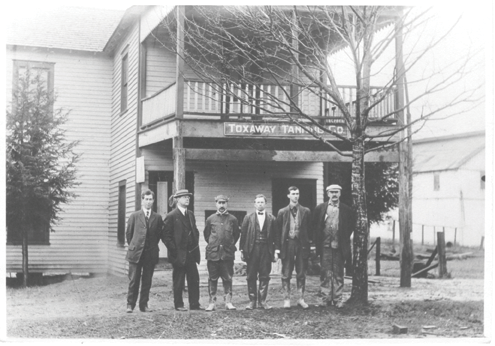
- The NC Good Roads Association was organized
1903
-
Transylvania Railroad extended from Toxaway to Lake Toxaway
-
Toxaway Inn was completed in the same year the railroad reached it
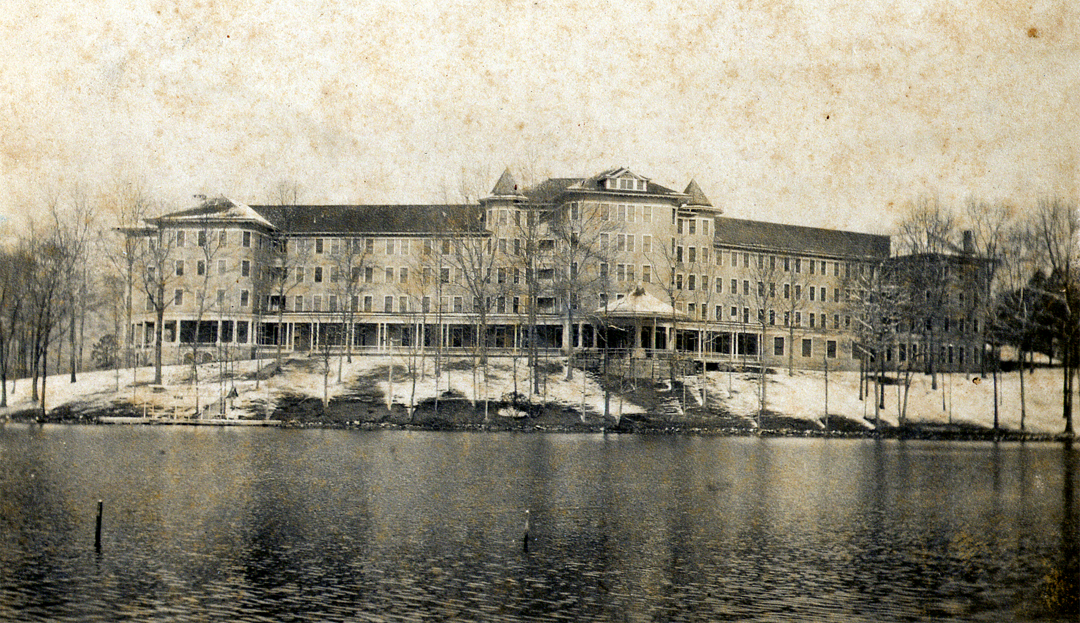
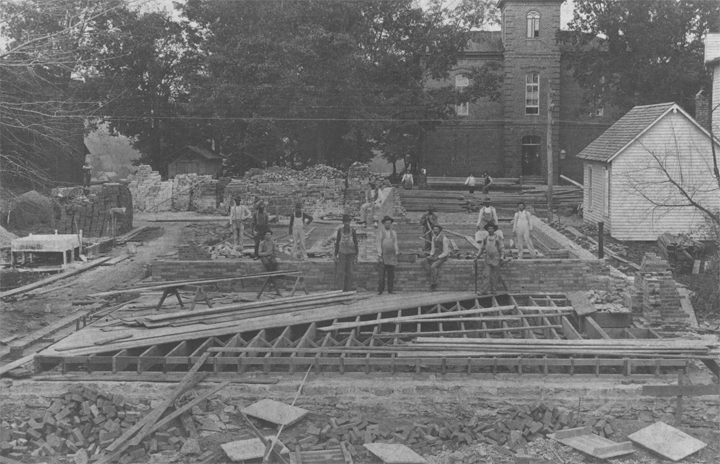
-
Construction began on the Aethelwold Hotel
1904
-
Aethelwold Hotel in Brevard completed by
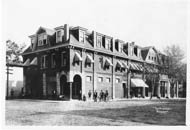
John J. McMinn -
Chestnut blight was discovered. Formerly a very common large tree of the Mountains and upper Piedmont regions of North Carolina. Because of the chestnut blight fungus (Cryphonectria parasitica), which was introduced on nursery stock of the Chinese Chestnut (C. mollissima) in New York City by the 1930s-1940s, almost all the large trees in North Carolina (and throughout American Chestnut's range) were killed back to the ground. This was an irreplaceable loss to some landowners in the mountains where as much as 1/3 of the timber in some areas was American Chestnut.
- By 1904 there were 37 schools in the county, three of which were for African American students
1905
-
T. C. Henderson had for some time been involved in local schooling. In 1905 he was elected Superintendent of all
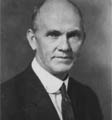 schools in the county. He served two terms, 1905 - 1917 and again 1923 -1929. One year after taking office (thus 1906) the first bond issue for schools was voted by district and immediately took effect. He worked tirelessly at getting improved schools in all the districts. He consolidated some schools, and built new school houses where necessary. He was instrumental in providing an 8 months school term for all grades and all ethnic groups. He also established public transportation for school children.
schools in the county. He served two terms, 1905 - 1917 and again 1923 -1929. One year after taking office (thus 1906) the first bond issue for schools was voted by district and immediately took effect. He worked tirelessly at getting improved schools in all the districts. He consolidated some schools, and built new school houses where necessary. He was instrumental in providing an 8 months school term for all grades and all ethnic groups. He also established public transportation for school children.
1906
-
Transylvania Cotton (spinning) Mill started on Whitmire Street, Brevard. Later known as Sapphire Cotton Mill and Pisgah Cotton Mill
-
Southern Railways signed a 50 year lease for use of Transylvania Railroad
- Transylvania County voters authorized the first issue of bonds for schools
1908
- First gas-powered car (a Reo) in the county, owned by Dr. Edwin S. English
1909
-
September 13: Contract signed for 18 houses on Whitmire Street for Pisgah Cotton Mill Village
-
Jim Aiken, businessman and widely popular friend, died as volunteer fireman when a
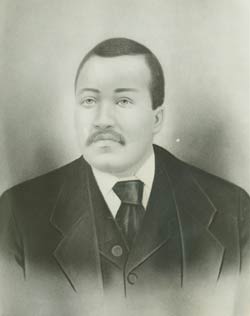 tanker truck turned over and exploded. He was the oldest son of Jane Aiken and father of Loretta “Moms Mabley”
tanker truck turned over and exploded. He was the oldest son of Jane Aiken and father of Loretta “Moms Mabley”
-
Cascade Lake was built in the Little River Community to produce electrical power for Brevard
- The Southern Appalachian Good Roads Association was formed
1910
-
Gloucester Lumber Company established by Joseph Silversteen after ac
 quiring
quiring
30,000 acres of forest land from George Vanderbilt. Gave rise to the Gloucester Company Store
-
There were approximately 30 hotels and boarding houses in Brevard
-
Brevard Institute, operated by the Methodist Women’s Missionary
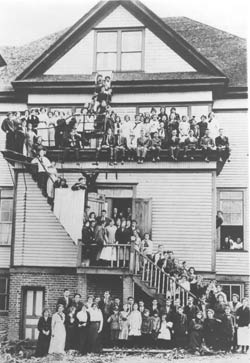 Society, flourished in the 1910s aand the 1920s.
Society, flourished in the 1910s aand the 1920s.
- Brevard #2 Colored School, forerunner of Rosenwald, opened for African-Americans.This was the first African American school in the county. Later there were three schools for African Americans, one located at Glade Creek, one in the Everett Farm area, and the county’s sole Rosenwald school in Brevard. Everett Farm closed due to low enrollment. The Glade Creek School consolidated with the newer Rosenwald School in 1948. It became the only school for African Americans until Transylvania County Schools desegregated in1962. Today the school serves as the administrative offices of the school system.
1911
-
The Weeks Act of 1911 provided authority to establish national forests in the eastern United States (similar forests had already been established in the western states), and thus a number of early purchases of forest tracts became formalized. The Pisgah National Forest was formally established in 1916. The first forest which was purchased was the 31,000 acre Gennet Purchase in northern Georgia. In 1921 Boone National Forest was added and in 1936 most of Unaka National Forest. In 1954 the Pisgah National Forest was administratively combined with Croatan and Nantahala National Forests to be known collectively as the National Forests of North Carolina.
- The Sylvan Valley News sold to Ora L. Jones
By Brian du Toit and Susan Threlkel of the Transylvania Sesquicentennial Steering Committee
Historical photos are courtesy of the Rowell Bosse North Carolina Room, Transylvania County Library




